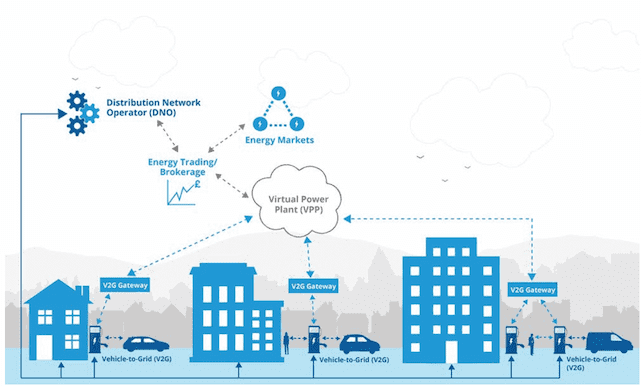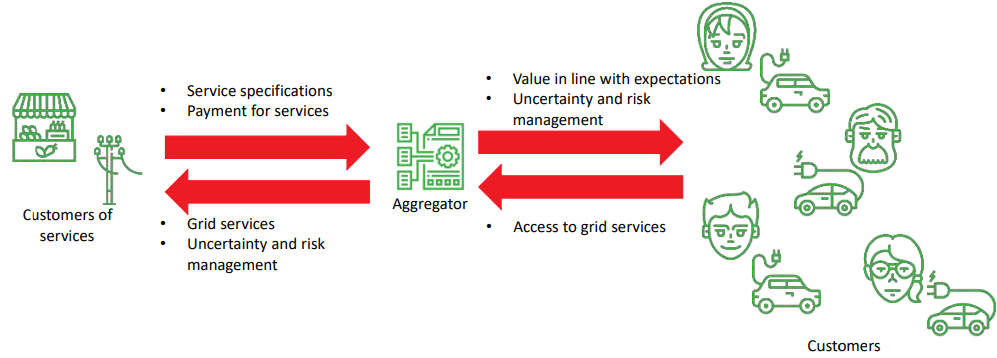Vehicle-to-Grid Demand Response Can Lead the Way for Decarbonizing City Fleets
Written by Soheil Mohseni and Alan C Brent
Cities are significant contributors to climate change. The sheer density of people relying on fossil fuels leaves urban populations particularly exposed to the consequences of climate change. Accordingly, innovative city development plans are increasingly integrating clean electric transport services and renewable energy generation. Electric vehicles (EVs) are progressively displacing internal combustion engine (ICE) vehicles, riding the wave of battery cost reductions and the worldwide drive towards sustainability and decarbonization. The city-wide smart grid paradigm provides the infrastructure needed to enable the efficient use of this new generation of EVs. Smart grids, backed by advanced information and communications technologies (ICTs), as well as artificial intelligence (AI) and big data analytics, manage and direct energy flows for maximum environmental, social, and financial benefits. Vehicle-to-grid (V2G) technology takes energy management in today’s smart grids a step further by allowing bi-directional energy flow between the grid and the EV’s battery. That is, the V2G technology transforms EVs into mobile batteries as distributed energy sources/sinks to buffer the grid in an intelligent manner – which fits within a broader landscape of smart energy management solutions in urban planning. In this setting, supervised EV charging/discharging infrastructure can communicate with the grid and control charging rates to effectively accommodate peak demand and the variability in renewable energy sources – and determine whether vehicles should be supplying/drawing electricity to/from the grid at any given time. However, this creates new challenges to network planning and practical implementation, necessitating fundamentally new strategies that adopt novel customer-centric services.
Introduction
Despite the fact that cities make up less than 2% of the Earth’s land surface, they produce more than 60% of greenhouse gas emissions and consume 78% of the planet’s energy resources, according to the UN’s Climate Action for Cities study [1]. A further challenge is a UN report’s projection that an additional 2.5 billion people will live in urban areas by 2050, highlighting the need for more sustainable urban planning and public services [2]. Accordingly, a green city revolution is critically needed across the planet. The revolution is less likely to be galvanized, as cities around the world are increasingly adopting innovative smart city concepts and technologies at a nearly imperceptible rate.
However, very few interconnected smart city initiatives can claim to be truly sustainable. According to a 2019 report by the Environmental Industries Commission (EIC), only a relatively insignificant fraction (about 20%) of the worldwide smart city development plans can be considered as verily environment-focused interventions [3]. In this context, it is increasingly evident that the main barrier to deploying green projects in an urban context is not the lack of technology, but rather the management of data generated by this technology. While the concept of a smart city encompasses disparate applications – from home appliances to on-street sensors – smart, sustainable city transportation solutions are one of the most popular and interesting smart city technologies. In addition, there is no doubt that the future of municipal transportation is electrified. This, however, has raised concerns around placing substantial strain on grid distribution systems.
A key challenge in the transition of the energy system to one dominated by sustainable energy sources is addressing the supply-demand mismatches as the penetration of variable renewables and less predictable loads increases. To effectively integrate non-dispatchable generation and new uncertain loads, sources of additional flexibility – across all energy system sectors – need to be evaluated on a socio-techno-economic basis. Energy storage, and particularly battery storage, plays a critical role in the least-cost set of solutions to increase system flexibility by providing energy shifting and ancillary services. Electric vehicles (EVs) consume by far the most battery production capacity on a global scale [4]. Rather than investing in cost-prohibitive grid-scale storage assets, utilities have identified a significant economic potential in utilizing EV battery capacity. EVs equipped with vehicle-to-grid (V2G) technology can provide valuable “storage on wheels” in general, but there is considerable uncertainty in the forecasted timing and location of charging and discharging.
The V2G Concept
The V2G technology enables a two-way energy flow between the EV’s battery and the wider utility network, transforming EVs into distributed energy storage assets. By shaving the peak load and, in turn, flattening the demand profile, V2G-enabled EVs can effectively support a reliable, resilient, affordable, clean future grid. Coordinated control signals from primary stakeholders in the V2G industry – the end-users/owners, energy retailers, service procurers, distribution network operators, and transmission system operators – can trigger the charging or discharging of the vehicle battery. Figure 1 illustrates the primary elements of the V2G technology [5].

Figure 1. Schematic representation of V2G operation (source: [5]).
The main physical elements of a V2G system are plug-in EVs, electric vehicle supply equipment that connects the vehicle to the grid, equipment that allows bi-directional flow of electricity (off-/on-board bi-directional chargers), advanced information and communications technologies (ICTs) mediating between EVs, service providers, and grid operators, as well as ubiquitous intelligent energy management systems [6]. The associated ICTs and energy management systems enable the operators to ascertain the status and availability of EVs for participation in V2G programs, schedule charge/discharge operations, control the fleet-grid interactions, and monitor the quantity and quality of services provided by EVs necessary for equitable compensation.
Smart, real-time data-orchestrated V2G solutions are increasingly powered by the Internet of Things (IoT) technology. Leveraging an interconnected IoT platform for V2G coordination provides central access to all data, sensors, and controls, thereby effectively managing the distribution of power across a fleet of subscribed V2G-compatible EVs – and ensuring that the optimal dispatch meets the set objectives. Advanced IoT capabilities address many of the key socio-techno-economic challenges of realizing the full value of V2G to support operating and investment decisions, particularly with regard to entering electricity markets purely for financial reward [7].
The Current Outlook, Opportunities, and Challenges
City-wide smart grids are identified as the key to intelligent EV charging/discharging coordination, offering the visibility and interoperability needed to electrify municipal fleets in the presence of a high share of variable renewables. Importantly, smart grids provide an effective platform for EV charging/discharging infrastructure to manage the associated sources of uncertainty in meeting the flexibility needs of electricity networks with a high penetration of non-dispatchable renewables, while adhering to the constraints of owners for the availability of their vehicles. More specifically, smart grids enable harnessing the discharge capability of EVs, providing an important tool for intelligent energy management in variable renewables-rich grids, whilst opening a new source of income for EV owners [8].
In a smart grid milieu, independent aggregators can unlock the true value of V2G demand response (DR) schemes, offering EV owners the opportunity to reap the full benefits of their flexibility potential. They, additionally, make an effective contribution to better meet industry parties’ technical requirements for particular routes to electricity markets, thereby playing a key part in helping power system operators maintain system balance in a cost-effective way. In principle, V2G-capable EVs and even V2G-equipped urban transit vehicles can all be integrated into a highly intelligent and responsive metropolitan grid by means of dedicated aggregators. Figure 2 illustrates the role of aggregators in integrating V2G-DR resources [9].

Figure 2. Schematic representation of aggregator-mediated V2G-DR operation (source: [9]).
Existing V2G-DR business models are predominantly based on market-oriented solutions that almost exclusively help avoid or defer costly reinforcement to the network, ignoring other important cost and revenue factors that are critical to support the associated financial value, stability, and market scalability aspects, particularly with regard to the role of third-party aggregators in supporting the commercialization and acceptance of V2G services. To aid the accurate formulation of business models for V2G services, an innovative new vision and strategic framework are fundamentally needed to better inform the energy sector, policy-makers, investors, manufacturers, urban planners, and the wider decision-makers of the significant business opportunity associated with optimizing the pooling of V2G-enabled EVs. This could primarily involve developing niche aggregator-mediated business models that adequately address energy democracy concerns and perceived risks, such as range anxiety and battery health. Not only will this will help extract additional value from existing enrolled users, but it will also enable extracting new value from otherwise untapped V2G-DR flexibility resources – necessary for moving towards the full convergence of energy, mobility, and urban transformations.
Conclusion
This article has highlighted areas where the V2G technology may create value in the context of sustainability transitions in urban settings. In particular, new value streams can be realized from the following inextricably linked benefits and services in an aggregator-mediated V2G-DR provisioning setting: (i) unlocking the potential of the V2G capacity to trade in various electricity and ancillary service markets, (ii) supporting the reliability and resilience of the power system, (iii) contributing to the affordability of highly self-sufficient community renewable energy systems, (iv) deferring or deterring network upgrades, providing congestion relief, and ensuring the adequacy of supply, as well as (v) implementing advanced battery scheduling strategies that protect battery state of health by providing low-energy, high-power grid services.
References
- UN-Habitat – for a better urban future. Innovate 4 Cities. [Online]. Available: https://unhabitat.org/topic/climate-change [accessed: 5-11-2021].
- United Nations – Department of Economic and Social Affairs. World Urbanization Prospects – The 2018 Revision. 2018. [Online]. Available: https://population.un.org/wup/Publications/Files/WUP2018-Report.pdf [accessed: 5-11-2021].
- Environmental Industries Commission. Strategy to reality: Getting smart cities to deliver for the environment. 2019. [Online]. Available: http://eic-uk.co.uk/wp-content/uploads/2019/11/Strategy-to-Reality.pdf [accessed: 5-11-2021].
- International Energy Agency. Global EV Outlook 2020 – Entering the decade of electric drive? 2020. [Online]. Available: https://www.iea.org/reports/global-ev-outlook-2020 [accessed: 5-11-2021].
- Cenex. Ebbs and Flows of Energy Systems (EFES). 2017. [Online]. Available: http://www.cenex.co.uk/vehicle-to-grid/efes/ [accessed: 5-11-2021].
- Cenex. A Fresh Look at V2G Value Propositions. 2020. [Online]. Available: https://www.cenex.co.uk/app/uploads/2020/06/Fresh-Look-at-V2G-Value-Propositions.pdf [accessed: 5-11-2021].
- NEC. How can IoT turn cities into smart cities? 2021. [Online]. Available: https://www.nec.co.nz/market-leadership/publications-media/how-can-iot-turn-cities-into-smart-cities/ [accessed: 5-11-2021].
- Darlene Steward. Critical Elements of Vehicle-to-Grid (V2G) Economics. National Renewable Energy Laboratory. 2017. [Online]. Available: https://www.nrel.gov/docs/fy17osti/69017.pdf [accessed: 5-11-2021].
- L. Jones, K. Lucas-Healey, B. Sturmberg, H. Temby, and M. Islam. The A to Z of V2G – A comprehensive analysis of vehicle-to-grid technology worldwide. 2021. [Online]. Available: https://arena.gov.au/assets/2021/01/revs-the-a-to-z-of-v2g.pdf [accessed: 5-11-2021].
This article was edited by Sara Paiva
To view all articles in this issue, please go to November 2021 eNewsletter. For a downloadable copy, please visit the IEEE Smart Cities Resource Center.


To have the eNewsletter delivered monthly to your inbox, join the IEEE Smart Cities Community.
Past Issues
To view archived articles, and issues, which deliver rich insight into the forces shaping the future of the smart cities. Older eNewsletter can be found here. To download full issues, visit the publications section of the IEEE Smart Cities Resource Center.



